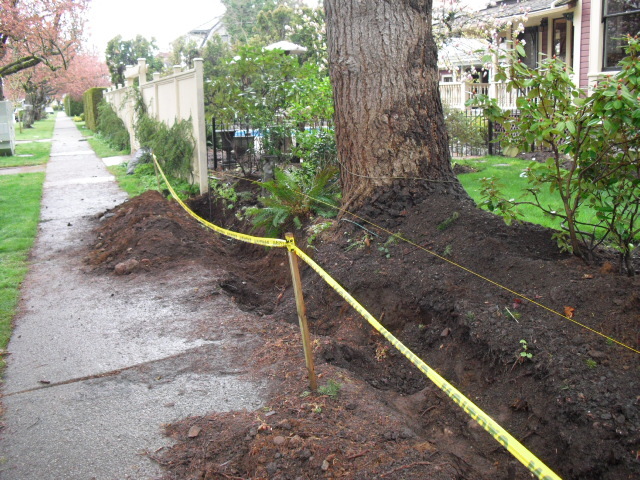Question
 Douglas fir
Douglas fir
I have a 150 ft douglas fir on the property line in the Pacific Northwest. On one side is my property and on the other is the city sidewalk, 10 feet of boulevard and then the street. There was a 30 year old cedar hedge along the property line which was reaching the end of its life and has been removed. Our plan is to plant 5 ft Taxus (yew) at a 2 ft interval to replace the cedars as yew is more shade tolerant. Privacy is is our main objective. While digging the trench for the new hedge trees, it became clear that there is not much room for root growth where the douglas fir sits. There is approx 3 feet between the fir and the sidewalk and there are three big roots going under the sidewalk - which has lifted. An image is attached.
Our question is whether, with proper irrigation and fertilization, the taxus or any other hedge tree has a chance for survival and growth, so that a proper privacy screen develops. Our preference is NOT to build a fence, but we will do that if we find that we do not have much of a chance for growing a proper hedge up against the douglas fir.
Will the yew hedge survive?
If no, is there another option?
AnswerSorry I think the space would be best for a fence--any tree will hang over the walkway and cause problems. You could use a privet type hedge where you can keep it pruned and this will grow in the space.
If you want privacy but prefer the softer look of greenery rather than a fence, plant a privet hedge. There are varieties that grow well in all climates. They will grow even in partial shade. The only thing they require is moist soil and regular pruning. Privet will grow into a thick, impenetrable hedge in only a few years
Step 1 Prepare the planting site. Plant privet hedges in full sun to partial shade. They prefer soil that is slightly damp, but will grow in almost any type of soil except sand. Remove any weeds and rake the surface of the soil smooth.
Step 2 Dig all of the holes before you plant any of the privet hedge. Space plants about 12 inches apart. Make sure you plant them at least 1 1/2 feet away from a boundary such as a wall or sidewalk.
Step 3 Improve the soil by adding a shovelful of compost to the bottom of each hole for the privet hedge. Use your garden claw to mix the compost in with the soil at the bottom of the hole.
Step 4 Place the plant in the hole and position it so it is growing at the same level as it was in the pot. Fill the hole half way up with soil. Firm the soil around the roots.
Step 5 Fill the hole half way up with water. Let it drain. Fill the hole with remaining soil, and firm down the surface of the soil with your foot.
Step 6 Make a ridge of soil around the outside of the planting hole. This will create a depression in the soil to catch water. Fill this with water and let it drain. Repeat.
Step 7 Water every other day for the first two weeks after planting. Thereafter, provide with one inch of rain per week






